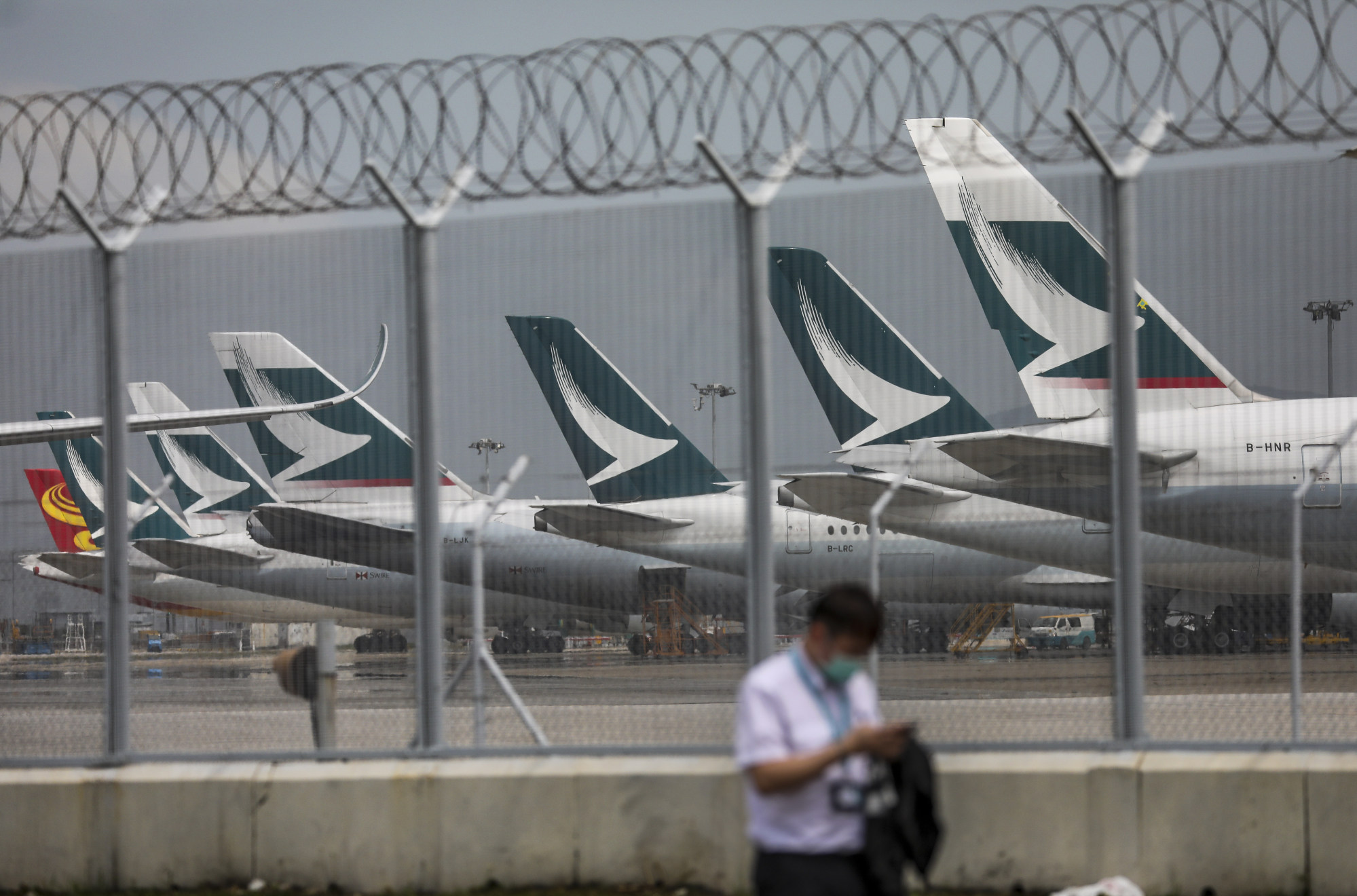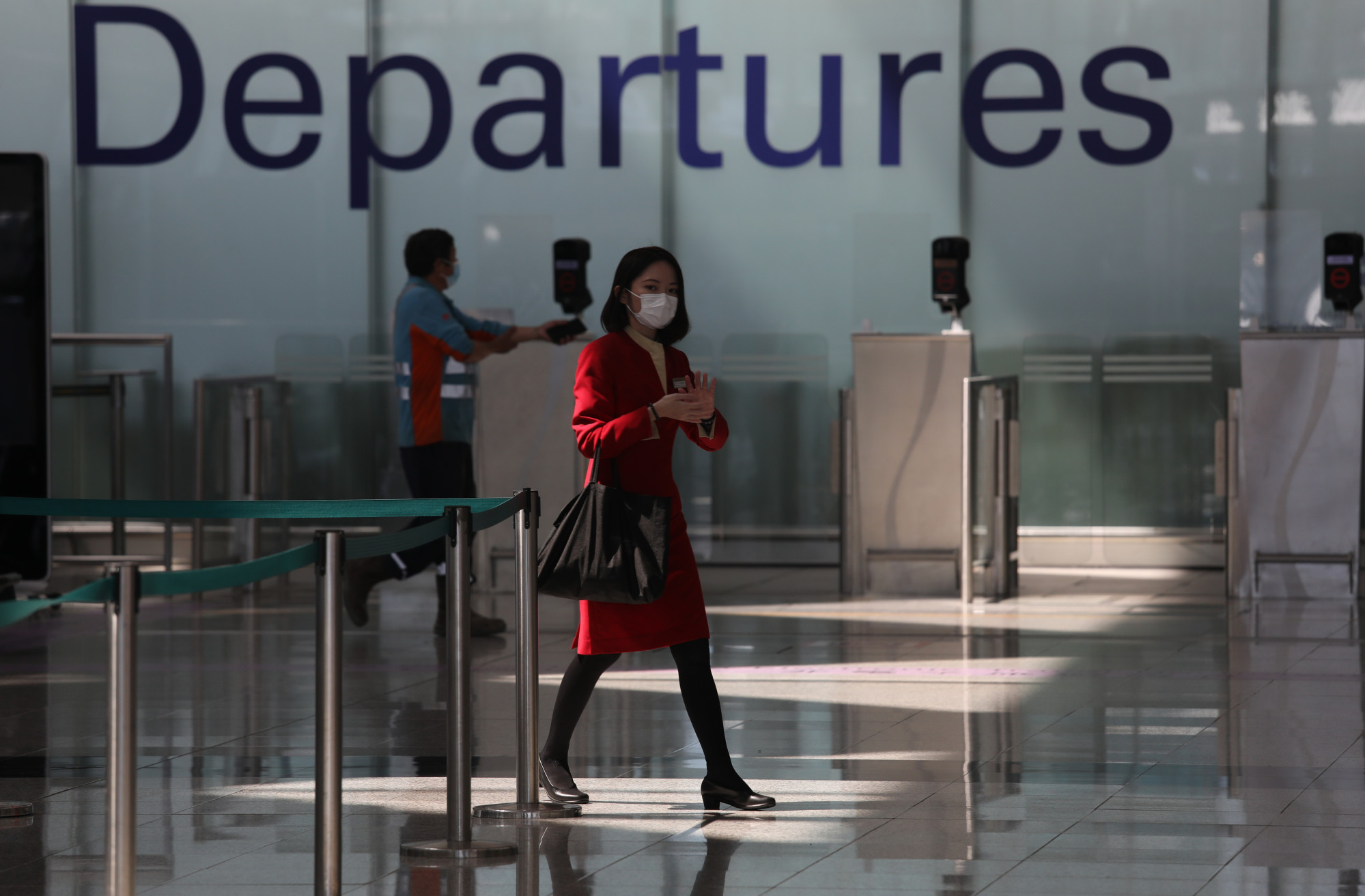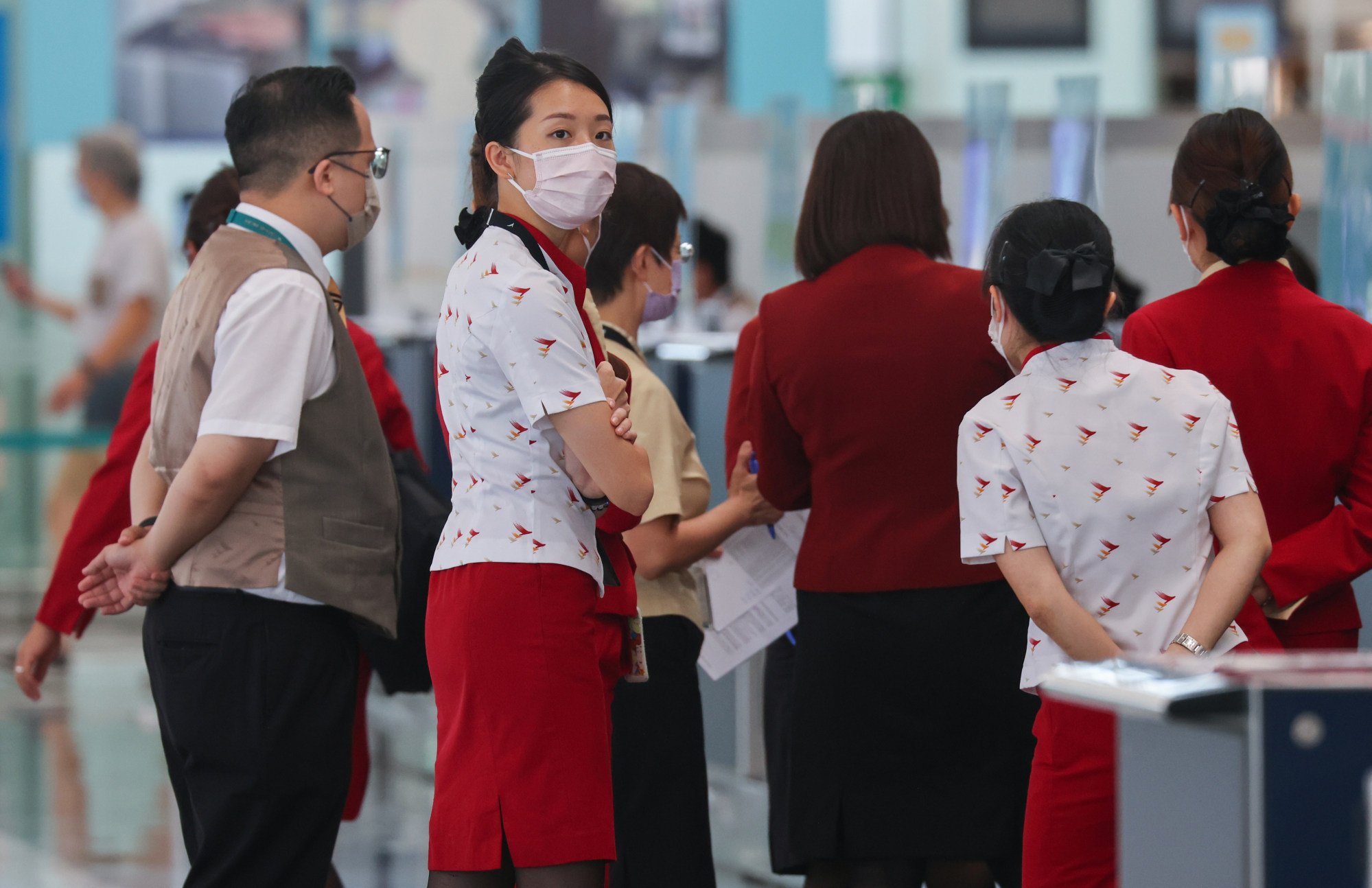
Hong Kong’s Cathay Pacific back on hiring spree in anticipation of take-off in global air travel, but faces recruitment challenges
- Hong Kong’s flagship carrier keen to add thousands to its roster by the end of next year, but finds some reluctant to return to industry still seen as unstable
- With a recovery in global air travel in sight, airlines are competing to hire and bolster staff in preparation
When Jasmine Lau received an email from Cathay Pacific Airways last month asking if she wanted to return to her old job as a flight attendant, she contemplated the proposition, but eventually decided against applying.
Almost two years after being laid off from the airline’s now-defunct subsidiary Cathay Dragon, the Hongkonger, who is in her 30s, is now working as an administrative officer in a bank.
“All my friends, we changed careers and now we are getting used to the new job and we don’t want to go back to something that is not secure and not stable,” said Lau, referring to herself and her flight attendant friends from Cathay Dragon.

She is among thousands whom Hong Kong’s flagship carrier let go in October 2020 when it shed 5,900 jobs, closed down Cathay Dragon and underwent a HK$39 billion (US$5 billion) restructuring led by the government.
Now, Cathay Pacific Group is looking to go on a hiring spree that will add 8,000 new staff across its subsidiaries. Some 4,000 of them will be recruited for Cathay Pacific Airways between now and the end of 2023, of which 700 will be pilots and 2,000 are cabin crew. The airline is looking ahead to a recovery in air travel, even as Hong Kong continues to stick to its “dynamic-zero” Covid-19 strategy.
In an interview with the Post on June 15, Cathay Pacific CEO Augustus Tang Kin-wing said the “direction of travel was there” and the airline wanted to be prepared as it took time to train and recruit new staff.
“We are very confident that Hong Kong will be opening up. We are making this preparation. We are making this commitment and investment in recruiting so many people ahead of time,” he said.
Hong Kong’s Cathay Pacific to hire 4,000 staff by end of 2023, CEO says
The city has relaxed its tough Covid-19 travel restrictions over recent months, but has stuck to mandatory hotel quarantine for travellers, including visitors, upon arrival at seven days and adjusted its flight suspension mechanism for airlines that bring in infected people.
Cathay has begun adding more flights, and plans to double its flight destinations from 29 at the start of the year to 60 by the end of 2022. Before the pandemic, it flew to 108 places.
But it faces competition from other carriers which are also in the market to hire. Start-up Greater Bay Airlines has been adding pilots and cabin crew to its roster as it plans its first commercial flight next month.
Travel disruption to spill into first quarter of 2023, head of IATA warns
Other airlines are also hiring and have struggled to recruit quickly enough to meet an increase in passenger demand over the summer, leading to flight cancellations, baggage chaos and long queues at airports from Sydney to Amsterdam.
Hundreds of British Airways workers at London’s Heathrow airport have voted in favour of strike action later this summer in a dispute over pay.
The city’s Gatwick airport has capped the number of flight departures and Amsterdam has also limited the number of passengers flying from its Schiphol airport during summer.
Willie Walsh, director general of the International Air Transport Association (IATA), warned on June 20 at the body’s annual meeting in Doha that the recent chaos at some major airports was a result of a “disconnect” between supply and demand of labour, and could spill into the first quarter of next year.

Demand is there, but will past employees return?
But while airlines and airports are now keen to rehire, some in the pool they are looking at, such as Lau, have found new careers and do not want to return to an industry still viewed as volatile.
Speaking to the Post last week on the sidelines of IATA’s annual meeting of more than 100 airline leaders, Walsh said the industry had lost a lot of talent due to downsizing. Having now found alternative employment, some might not be attracted back, he added, calling it one of the “hangover effects” the industry was currently suffering.
In Lau’s case, she sent out hundreds of resumes to banks, applying for jobs in customer service and sales after she was laid off in 2020.
She lived with her parents in Tuen Mun to save money and finally landed a job in insurance, but being in front of a computer five days a week was a far cry from her nine years as a flight purser for Cathay Dragon.
She has now landed on her feet, moved out of her parents’ flat and secured another job working for a bank, earning more than she did as a flight attendant.
While she missed interacting with passengers, she said she had become used to the stability and enjoyed the ability to go on weekend hikes or gatherings with her family.
“I can plan something ahead. It is not like before where sometimes you have to be on standby. You don’t know if you’re staying in Hong Kong or not,” she said.
She is not alone in her reluctance and airlines know the challenges they face in recruitment.
Some former flight attendants have started new careers, and with the basic salary starting at HK$9,000 per month, Cathay Pacific Airways Flight Attendants Union vice-chairwoman Grace Siu Wing-yan said those with decades of experience might not be willing to rejoin.

“For those who have been flying for around 20 years, were flight or senior pursers, or some of them even managers, it is a big decision. Am I going to start over again? It concerns not only money but also their career paths as well,” she said, adding that the airline would also be targeting eager new graduates in its hunt for new employees.
The Covid-19 pandemic contributed to Cathay Pacific’s workforce shrinking 37 per cent from 2019 to the end of 2021. At the end of last year, the group employed more than 21,600 people worldwide, including about 17,700 in Hong Kong.
Siu noted that the number of cabin crew had also plummeted by around 40 per cent, from 11,000 before 2020 to around 6,000 now.
Fledgling carrier Greater Bay Airlines has also been trying to beef up its roster, ahead of its first scheduled commercial flights to Bangkok next month.
Cathay Pacific expecting smaller losses in first half of 2022
In an interview with the Post on June 14, chief executive Algernon Yau Ying-wah said there were plenty of cabin crew in the market, but admitted some had found new jobs in insurance, property or in the food and beverage industry.
“Once they stabilise, many of them may not be coming back,” said Yau, who subsequently resigned and was appointed Secretary for Commerce and Economic Development Bureau.
Greater Bay has 30 pilots to fly three leased Boeing 737s as part of a 150-strong workforce. About 90 per cent of its cabin crew are former Cathay Dragon staff.
“So we need some new blood coming in and we have so many graduates every year … Many young girls, young guys would like to join as cabin crew. They love the job. They love flying,” Yau said.

Cathay’s tricky task: stave off rivals while retaining stable of pilots
It all makes for an aviation industry that has now become a jobseeker’s market. In particular, a notable number of former Cathay pilots are now available to be snapped up by rival airlines.
According to Hong Kong Aircrew Officers Association, the Cathay Pacific pilot union, the number of pilots flying for the airline has shrunk from almost 4,000 before the pandemic to about 2,500 currently.
Cathay’s government-backed restructuring in 2020 also came with new, cheaper employment contracts for flight crews. It means a reduction in pilots’ pay by around 40 per cent, and a drop in housing and retirement benefits.
Cathay Pacific CEO Tang also noted a spike in the resignation rate of pilots in November last year, after the Covid-19 infections of three flight crew led to more than 150 Cathay Pacific staff and their families sent to the government’s isolation facility at Penny’s Bay.
“Since then the turnover has reduced, although it is still at a relatively higher level than the historical average,” he said.

A senior union official, speaking on condition of anonymity, said a lot of Cathay Pacific pilots, including expatriates, had resigned of late, and other airlines, such as US carriers, had been approaching aircrew to try to poach them.
“There is fierce competition for Cathay’s pilots. There are resignations every other day,” the official said.
The insider added that when comparing factors such as cost of living, time needed for progression and schooling fees, the packages at other airlines “work out better”. Considerations such as fewer restrictions that allow aircrew to leave their hotels in other countries also play a role in making competitors more attractive.
In a bid to retain crew following a raft of resignations, the airline announced a plan in April this year to raise pilot allowances, depending on their ranks.
Starting from next year, the most senior captains will get a monthly handout of HK$36,000, amounting to HK$432,000 (US$55,000) annually. It would be a 9 per cent increase from what they received previously, and comes on top of base salaries and hourly flying rates, according to a Cathay source. The airline will also increase the annual education allowance for pilots’ children
Pilots who joined the airline from 2018 will receive an annual basic salary of HK$376,608 for an entry-level second officer, HK$577,500 for an entry-level first officer and “up to” HK$1.2 million, under a contract known as COS18, which is similar to packages offered by Singapore Airlines.
Cathay Pacific to re-hire hundreds of cabin crew ahead of ‘aviation recovery’
But the rates are still much lower than for aircrew who signed a contract known as COS08 in 2008 and received HK$488,964 as second officers, HK$975,504 as first officers and up to HK$2.1 million as top-level captains.
Another discouraging factor is that pilots who have moved airlines must work their way up the ranks again, to be fair to existing flight crew.
Andrew Yuen Chi-lok, of Chinese University’s Aviation Policy and Research Centre, said with a global shortage of pilots and given the faster recoveries in other aviation markets, some pilots had left Hong Kong.
While Cathay Pacific had restarted its cadet pilot programme with the Hong Kong Polytechnic University, he said it would take more than a year for training and new trainees would only be able to fill the gap of junior positions.
“There will still be challenges to have enough senior pilots to prepare for the recovery in the coming months,” Yuen said.

Now hiring: Asia’s airports and airlines
As Asian countries reopen their borders and Covid-19 curbs on travel fall away, carriers in the region are placing job adverts to hire workers in anticipation of a return of demand.
Singapore Airlines told the Post in a statement that after a two-year hiatus, it was now aiming to recruit about 2,000 cabin crew in 2022 to replace staff who left. It has no plans to hire pilots.
“Since the restart of our cabin crew recruitment drive in March this year, we have selected over 800 applicants to date. Of these, around 60 per cent are returning crew,” a spokeswoman said.
How Singapore Airlines beat the pandemic and came out ahead
Korean Air said it was planning to hire pilots for its Airbus A380, “to secure sufficient operational readiness in the event that more A380s return to serve our network to satiate post-Covid air travel demand”.
The airline operates four times a week to and from Hong Kong and will increase to daily flights from July, but “further capacity increase will depend on Hong Kong’s policies”.
Taiwan’s Eva Air said it was not hiring ground staff or cabin crew, but was accepting applications for pilots.
The airline will maintain four flights a week from Taiwan to Hong Kong until the end of July, and “make necessary adjustments to serve the revived market demand then”.
Shukor Yusof, of aviation advisory firm Endau Analytics, said staffing problems were becoming a “major issue” for airlines that had laid off workers during the pandemic.
Airports in Southeast Asia, such as Singapore’s Changi and Kuala Lumpur International Airport, were facing similar staff shortages and there were expectations that up to 20 per cent of flights could not be operated as scheduled this summer as a result, he added.
Hongkongers head to Japan for first time in 2 years; city logs 1,447 Covid cases
Independent aviation analyst Brendan Sobie said the manpower constraints in the region lay more at the airports, particularly in ground handling. The security clearances required for airport work can also drag on hiring, further compounding the problem.
Changi was looking to fill 6,600 vacancies at a job fair last month, with an emphasis on frontline staff. It will reopen two of its terminals closed because of the pandemic and has already partially reopened Terminal 2 to meet demand.
Changi Airport Group (CAG) is looking to fill 250 vacancies in the year ahead, with 50 per cent of them operational roles.
Goh Hwai Kar, senior vice-president of the group’s people team, said the new staff were needed “to ensure CAG has adequate manpower to manage the increase in passenger traffic as travel resumes”.
In Singapore, aviation jobs are up for grabs as tourism rebounds
“The aviation downturn and an uncertain industry outlook over the past two years had made hiring challenging. However, the underlying factors for long-term growth in this sector remain strong,” he added.
Latest figures show the airport handled 2.4 million passengers in May. Hong Kong International Airport handled 170,000 passengers in the same month. The latter said it was working closely to prepare for a return of passengers, with most of the food and beverage outlets in the non-restricted area of the terminal now open.
“As adequate manpower holds the key to smooth airport operation, Airport Authority Hong Kong will continue to closely monitor the demand and work with business partners to ensure adequate manpower at Hong Kong International Airport when passenger traffic recovers,” a spokesman said.
While some have been hesitant to return to a job in the skies, Isaac Leung Ka-fung has been waiting almost two years for the opportunity to take off again.
The 39-year-old worked for seven years as a ground staff member, before realising his dream of becoming a flight attendant. He rose through the ranks and was a purser for seven years at Cathay Dragon before being laid off in 2020.
‘Rusty’ aviation industry will need time to get flowing again, airline boss warns
Leung has been working as a personal assistant for a golf coach, but has found it difficult adjusting to a new industry. He said he missed the lifestyle, flying and had been waiting for his chance to go back to aviation.
“I really want to continue chasing my dream in the airline industry. As a cabin crew, it is not only a job, it is my life career,” he said.
Walsh said Asian airports and airlines should aim to avoid the mistakes made by its European and American counterparts after they overestimated their ability to meet greater manpower needs quickly.
“I think the lesson from watching what’s happened with the build-up capacity in the US and in Europe is you need to plan for it being more difficult to recover,” he said.


